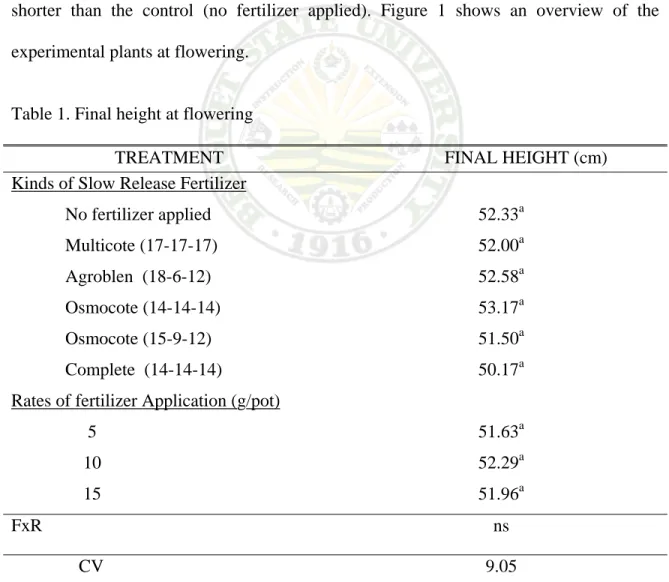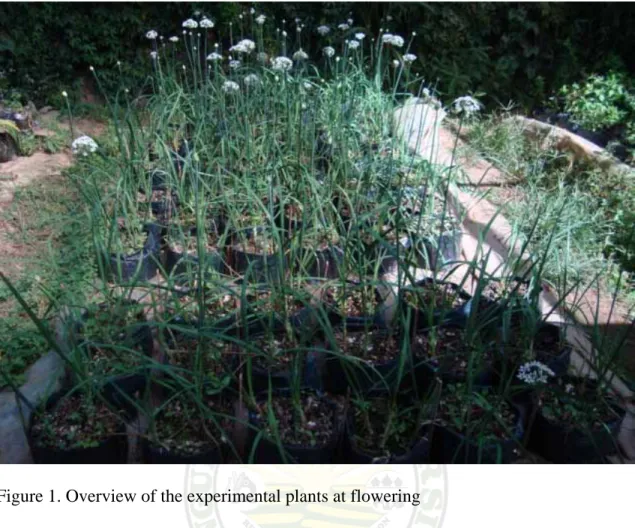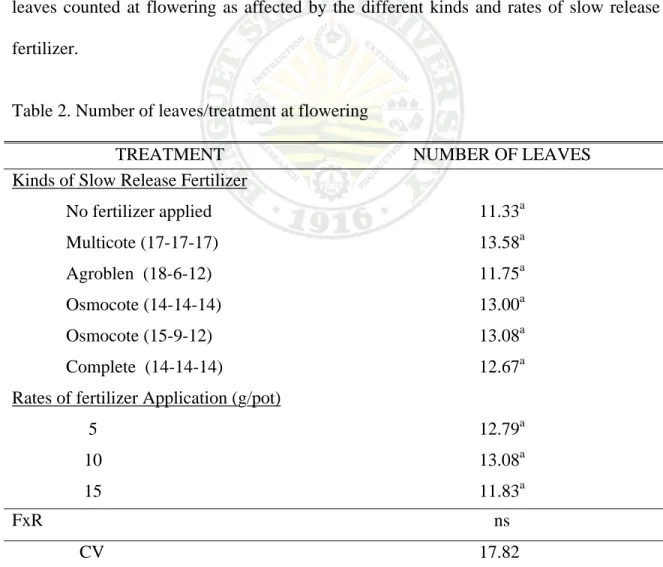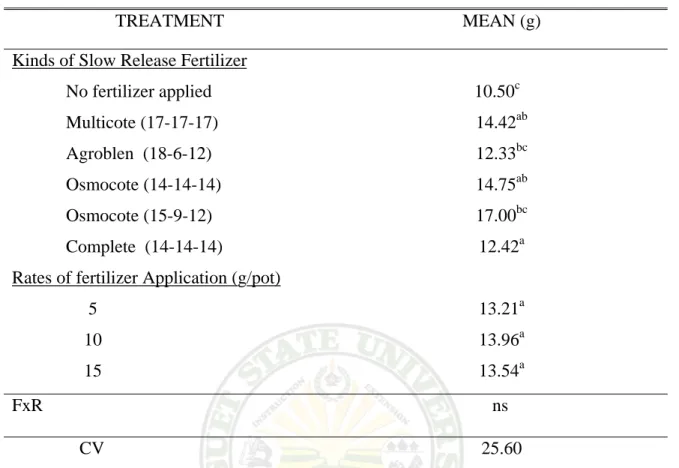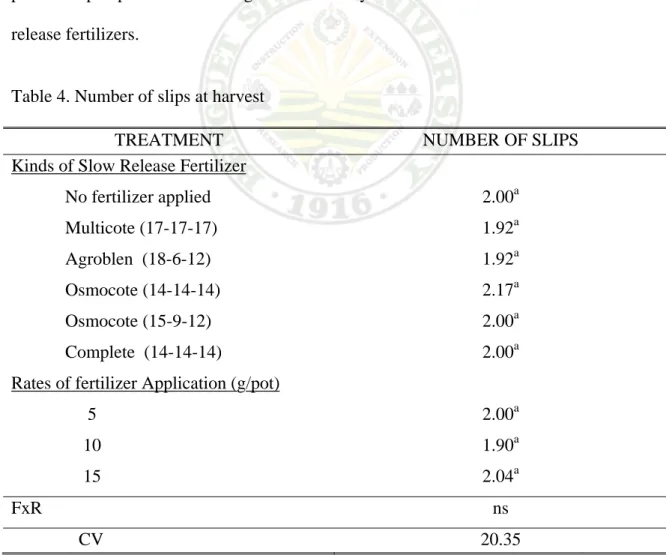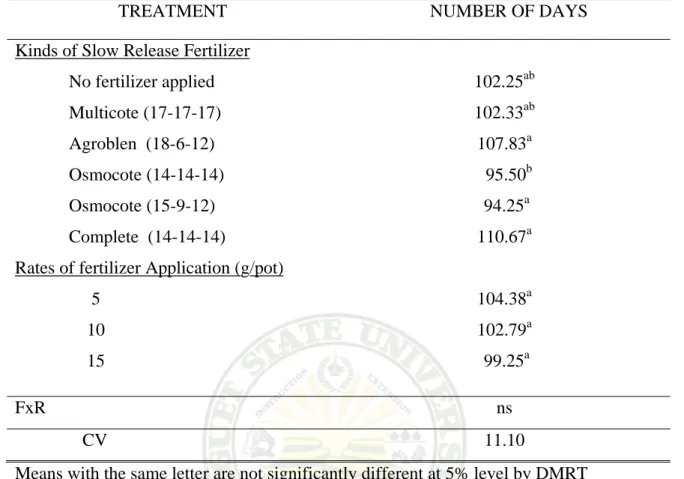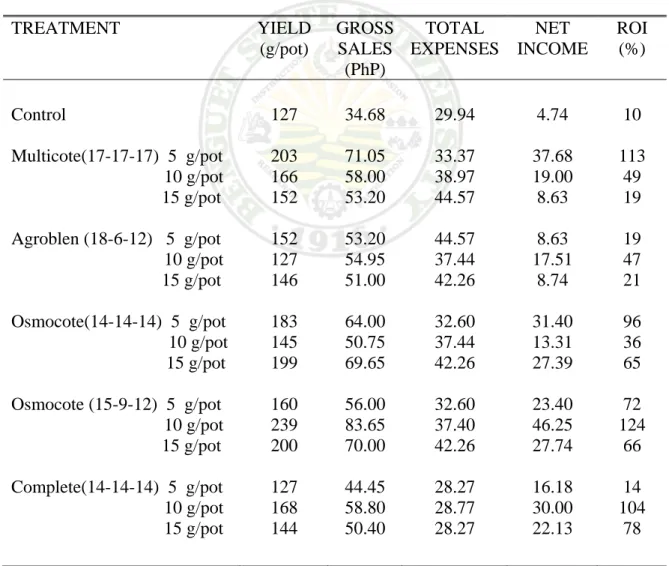FERNANDEZ, HERMA V. APRIL 2010. Growth and Yield of Chives (Allium schoenoprasum as Affected by Different Kinds and Rates of Slow Release Fertilizer.
Benguet State University, La Trinidad, Benguet.
Adviser: Araceli G. Ladilad, Ph.D.
ABSTRACT
The study was conducted to determine the efficacy of using slow release fertilizers on the growth, flowering and yield of chives, determine the appropriate kinds and rates of slow release fertilizer that can be used profitably for chive production under La Trinidad Benguet Condition and the economics of using the different slow release fertilizers in Chive production.
Results shows that the different kinds of slow release fertilizers had not significantly affected the height of the plants, number of leaves and number of slips produced at flowering. Application of Osmocote (15-9-12) and Osmocote (14-14-14) promoted earlier flowering of chives.
The different rates of slow release fertilizer application did not affect significant differences in all parameters gathered. Only slight differences were recorded on the growth and yield of the plants as affected by the different rates of application.
of ROI, meanwhile 10 g/pot of Multicote (17-17-17) had also a comparable yield and ROI.
Page
Bibliography………. i
Abstract……… i
Table of Contents ……… iii
INTRODUCTION………... 1
REVIEW OF LITERATURE……….. 4
MATERIALS AND METHODS ……… 7
RESULTS AND DISCUSSION Plant Height at Flowering (cm)……… 10
Number of Leaves per Plant at Flowering………. 11 Weight of Harvested Leaves ….………….……… 13
Number of Slips at Harvest………. 17
Number of Days from Planting to Flower Bud Formation……….... 18 Return On Investment…..………... 19
SUMMARY, CONCLUSION AND RECOMMENDATIONS……… 21
Summary………..………... 21
Conclusions………... 22
Recommendations………... 22
LITERATURE CITED………..……. 23
APPENDICES………..….. 24
INTRODUCTION
Chive (Allium schoenoprasum L.) belongs to the Amaryllis family, Amaryllidaceae, which are clump forming perennials. They are the smallest species of the onion family, they grow 30 to 50 cm tall. The bulbs are conical and measuring 2 to 3 long and 1 cm wide. They grow clustered from the roots instead of growing individually, the leaves are hollow, tubular, almost grass- like in shape and grow up to 50 cm long and 2 to 3 mm in diameter, the leaves are chopped and used as garnish and flavoring in salads, dips, soups, and cheeses due to its mild onion flavor. Flowers are pale purple and white, star-shaped with six petals, 1 to 2 cm wide that are produced in a dense inflorescence surrounded by papery bract border; it is edible and contain large amounts of Vitamin C. Nowadays herb are most commonly known for their culinary, medicinal, aromatic and decorative qualities (Poincelot, 2004).
Osmocote and Multicote fertilizer formulations which are controlled release fertilizer can be applied in soil from the field capacity to permanent wilting capacity point moisture level with no significant differences in the rate of nutrient release in wide ranges of soil pH 4.0 to 6.9. Osmocote and multicote formulations upon applications, the nutrients are released over a period of time. Osmocote has three to four months longevity (14-14-14) and Multicote (17-17-17) has three months longevity. Multicote granule is a mixture of NPK encapsulated into biodegradable polymer coating that does not contain Chlorine. Osmocote granules are coated with resin and when moisture penetrates the coating, it will make salts soluble. Slow release fertilizer compared to the other forms of fertilizers has minimum detrimental effects on the soil and atmospheric environments due to the controlled release of nutrients into the soil solution and ground water, preventing
further deterioration of global environment. Since Osmocote and Multicote releases slowly, it does not cause injury of seed and roots of developing plants. A study conducted by Rehm (1994) showed that a sustained profit in a farm enterprise is highly dependent on achieving optimum yield with most efficient use of inputs.
Most plants was lost or will revert to less desirable forms unless they are domesticated and propagated under controlled conditions that preserve the unique characteristics that make them useful (Hartmann et al., 1986).
At present, most of the farmers spend a big percentage of their capital for fertilizers alone. Most of them also prefer a quick release type of fertilizer because they want to see the immediate effect to their crop in a shorter span of time as possible. In reality they are not aware that they are not following the efficient and right amount of fertilizers applied, maybe sometimes they obtained less profit from the previous croppings so they add more fertilizers the following cropping in hope of greater yield.
The result then is that they are degrading their soil and rendering it to be more acidic soil.
Slow release type of fertilizer is proven to be more economical because one application per cropping is sufficient to supply the required nutrient of crops, and an efficient way of taking care of the soil.
Chives are grown not as a main crop, in most cases they are grown as secondary crop. Some gardeners used chives as a perennial edging or border plant in an herb garden because of their leaves and flower for culinary and medicinal uses. Fertilizing them therefore is necessary, so it is essential to know the best type of slow release fertilizer used and the right amount that best correspond to their required need until harvest.
The study was conducted at the Benguet State University Ornamental Research Area, La Trinidad Benguet from October to March 2010 to determine the efficacy of using slow release fertilizers on the growth, flowering and yield of chives; determine the appropriate kinds and rates of slow release fertilizers that can be used profitably for chive production under La Trinidad, Benguet, determine the economics of using the different fertilizer treatments.
REVIEW OF LITERATURE
The Plant
Chives are a member of the onion family; it grows to about 45 cm in height and produces an attractive purple and white flower similar to pom-pom in shape. Chives are perennial plant and can also be used as an organic means of repelling aphids.
Fertilizer Application
Fertilizer is one of the most important ingredients of the total recipe to grow plants. Plants do need water, air, light, nutrition, soil and temperature all in right ratio at the right moment and during all right period (Scotts, 1996). The rate of application of chemical fertilizers depend such factors as: 1) the character of the soil; 2) the previous crop grown and the manner in which it was fertilized; 3) the moisture conditions; 4) the importance of early maturity; 5) the possibility of early irrigation; 6) the amount of land available; and 7) the amount of fertilizer to be applied to the soil depends on the recommended rate of application and the percentage nutrient content or grade of the fertilizer materials (Watts, 1972).
Faustino (1998), mentioned that slow release fertilizers promised to be the acceptable method of fertilization from an environmental stand point of view. They currently occupy a small niche in the over all market for chemical fertilizer, as technologies continue to evolve.
French and Alsburg (1989), cited that the major advantage of slow release fertilizer is that a single application can provide the majority of the nutrient for the
growing season. Following the necessary method of application, production of superior quality plants can be obtained.
Buyas (1994), found that basal application of N-P2O5-K2O was needed to promote the growth of stems and leaves of plants
Day-a (1987), mentioned that plant fertilized with slow released fertilizer through Osmocote were pale green but were predominantly fibrous.
Fertilizer Rates
Chaong (1987), stated that application of 75-75-75 or 100-100-100 kg NPK/ ha improved plant height, increased the number of leaves produced at anthesis, produced longer stem, bigger blooms, greater number of suckers per plant and increased yield of cut flowers per area in Shasta daisy.
Day-a (1999), applied Osmocote Triple 14 and Multicote Triple 17 slow release fertilizer formulations in chrysanthemum cut flower production, applied as basal fertilizer at the rate of 60-60-60 kg NPK/ha. She found that Osmocote Triple 14 and 70-70-70 kg NPK /ha Multicote is beneficial in the production of quality chrysanthemum cut flowers.
Torio (2000), also showed that comparable plant height, number of leaves, total leaf area, stem length, cut flower yield, flowering and duration of flower development were recorded in snapdragon fertilized with 70-70-70, 90-90-90 and 120-120-120 kg N- P2O 5-K2O /ha.
Aust (2008), slow release fertilizer are generally comprised of organic, natural, or recycled materials, making them much more healthy for the environment. They also release the appropriate amount of nutrients to your vegetables and flowers without wasting material or requiring frequent re-application. These fertilizers also tend to stay
around longer in garden. If it is applied large amount, the plant roots will not be burned because only a little is released at a time, and the fertilizer will be available over a long period of time which means the gardener does not have to re-apply fertilizer as often.
Slow release fertilizer helps reduce water pollution because it is not which soluble and nutrient are released in useful amounts means they aren’t washed away in storm water run-off.
Quick release fertilizers are readily available to a plant and are often water soluble. With slow release, the nutrients are released over a period of time, which is sometimes dependent on temperature and the amount of moisture that’s provided to the plant.
MATERIALS AND METHODS
The materials used in the study were bulbs of chives, different kinds of slow release fertilizers, measuring sticks, foot rule, plastic pots (6 inches in diameter), weighing scale, and labeling materials.
The study was laid out following the Randomized Complete Block Design (RCBD) in Factorial arrangement replicated four times. The different kinds of slow release fertilizers was assigned as Factor A and the rates of application as Factor B. There were three sample plants per treatment replication. The treatment was as follows:
Factor A: Kind of Slow Release Fertilizer F1-No fertilizer applied F2- Multicote 17-17-17 F3- Agroblen 18-6-12
F4- Osmocote 14-14-14 F5- Osmocote 15-9-12 F6- Complete 14-14-14
Factor B- Rates of fertilizer Application (g/pot) R1- 5
R2- 10 R3- 15
Planting. Three healthy bulbs of chive were properly planted per pot, following the recommended spacing.
Fertilizer application. The different fertilizer treatments were applied once, at planting time.
Growing media. The soil used as growing media is a mixture of sandy loam and BSU compost in a 2:1 ratio.
Care and maintenance. Cultural management practices such as weeding, crop protection and irrigation were done uniformly as recommended.
Data gathered. The data gathered was tabulated, computed and the means was compared using the Duncan’s Multiple Range Test (DMRT).
A. Vegetative Growth
1. Final height at flowering (cm). These were obtained by measuring the final height of the plant from the base up to the flowering at close bud stage.
2. Number and weight of leaves per plant at flowering (g). This was gathered by counting the number and weighing of leaves at flowering.
3. Number of slips produced at harvest. This was taken by counting the number of slips produced during harvest.
B. Reproductive Growth
1. Number of days from planting to flower bud formation. This was the duration from planting to the formation of 1 cm bud size.
C. Yield and Yield Components
a. Total weight of harvested chives per treatment (g). This was taken by weighing the harvested chive leaves.
D. Occurrence of insect pests and diseases
E. Cost and return analysis. The study was recorded and the return on investment was computed using the formula.
ROI (%) = Gross sale – Total expenses x 100 Total expenses
F. Documentation of the study. This was obtained through pictures from flowering stage and harvesting.
RESULTS AND DISCUSSION
Plant Height at Flowering
Effect of kinds of slow release fertilizer. The height of the experimental plants at flowering was measured at close bud stage. Result show that there were no significant differences noted on the plant heights as an effect of the different kinds of slow release fertilizer applied (Table 1). There were slight differences in plant height among the different treatments. Osmocote (14-14-14) had the tallest plant with a mean of 53.17 cm, while complete (14-14-14) recorded the lowest mean on height measurement which is shorter than the control (no fertilizer applied). Figure 1 shows an overview of the experimental plants at flowering.
Table 1. Final height at flowering
TREATMENT FINAL HEIGHT (cm)
Kinds of Slow Release Fertilizer
No fertilizer applied Multicote (17-17-17) Agroblen (18-6-12)
Osmocote (14-14-14) Osmocote (15-9-12) Complete (14-14-14)
Rates of fertilizer Application (g/pot) 5
10 15
52.33a 52.00a 52.58a 53.17a 51.50a 50.17a
51.63a 52.29a 51.96a FxR ns
CV 9.05
Means with the same letter are not significantly different at 5% level by DMRT
Figure 1. Overview of the experimental plants at flowering
Effect of rate of application. Table 1 shows that there was no marked differences rated among the rates of fertilizer applied with 10 g/pot was slightly taller (52.29 cm) than the other treatment, 5g/pot and 15 g/pot with a mean of (51.63) and (51.96) respectively.
Interaction effect. There was no significant interaction effect noted on the kinds and rates of fertilizer applied on the measured height of the plants.
Number of Leaves per Plant at Flowering
Effect of kinds of slow release fertilizer. There were no appreciable differences recorded on the average number of leaves of the plants as counted at flowering stage.
There were slight differences but statistically it was found not significant; Multicote (17-
17-17), Osmocote (15-9-12) and Osmocote (14-14-14) produced the highest leafcount at flowering with a mean of 13.58, 13.08 and 13.00 respectively. Meanwhile control (no fertililizer applied) produced the lowest leafcount at flowering with a mean of 11.33 (Table 2).
Effect of rates of application. As shown in Table 2, there were no significant differences realized statistically on the leaf count per plant at flowering as an effect of the different rate of application. The highest mean was recorded on the 10 g/pot rate of application.
Interaction effect. There were no interaction effect realized on the number of leaves counted at flowering as affected by the different kinds and rates of slow release fertilizer.
Table 2. Number of leaves/treatment at flowering
TREATMENT NUMBER OF LEAVES
Kinds of Slow Release Fertilizer
No fertilizer applied Multicote (17-17-17) Agroblen (18-6-12)
Osmocote (14-14-14) Osmocote (15-9-12) Complete (14-14-14)
Rates of fertilizer Application (g/pot) 5
10 15
11.33a 13.58a 11.75a 13.00a 13.08a 12.67a
12.79a 13.08a 11.83a
FxR ns
CV 17.82
Means with the same letter are not significantly different at 5% level by DMRT
Weight of Harvested Leaves
Effect of kinds of slow release fertilizer. Result of the weight of harvested leaves per plant as affected by the different kinds of slow release fertilizer shows that there was a highly significant difference among the treatments (Table 3). Osmocote (15-9-12) recorded the heaviest harvested leaves with an averege of 17 g per plant followed by Osmocote (14-14-14) and Multicote (17-17-17) with an average weight of 14.75 and 14.42 respectively. Meanwhile the control (no fertilizer applied) had the lowest weight of harvested leaves. This is because it was observed that although there was no significant differences noted on the number of leaves produced at flowering among the treatments, the harvested leaves on the plants applied with Osmocote (15-9-12) was wider and thicker in comparison with the leaves produced by the unfertilized plants (Control).
Effect of rates of application. Table 3 shows that although not statistically significant result showed that application of 10 g/pot of the different kind of slow release fertilizers recorded the heaviest leaves harvested per plant. Application of 10 g/pot had an average weight of 13.92 g while the lightest was recorded on application of 5g/pot.
Interaction effect. There were no significant interaction effects realized between the kinds and rates of slow release fertilizer on the weight of chive leaves harvested.
Figure 2 and 3 shows the harvested chive leaves as affected by different kinds and rates of slow release fertilizers.
Table 3. Weight of harvested leaves
TREATMENT MEAN (g)
Kinds of Slow Release Fertilizer
No fertilizer applied Multicote (17-17-17) Agroblen (18-6-12)
Osmocote (14-14-14) Osmocote (15-9-12) Complete (14-14-14)
Rates of fertilizer Application (g/pot) 5
10 15
10.50c
14.42ab 12.33bc 14.75ab 17.00bc 12.42a
13.21a 13.96a 13.54a FxR ns
CV 25.60
Means with the same letter are not significantly different at 5% level by DMRT
Figure 2. Harvested chive leaves as affected by different kinds and rates of slow release fertilizers
Figure 3. Harvested chive leaves as affected by different kinds and rates of slow release fertilizers
Number of Slips at Harvest
Effect of kinds of slow release fertilizer. Results of the number of slips produced per plant at flowering shows that there was no differences among the treatment (Table 4).
Almost all of the treatments produced an average of two slips at flowering. Slightly higher slip counts was recorded on Osmocote (14-14-14) with a mean of 2.17.
Effect of rates of application. Table 4 reveals that there was no marked difference on the number of slips produced by the plants as affected by rates of slow release fertilizer. Almost all plants produced a mean of two slips.
Interaction effect. There were no interaction effects on the number of slips produced per plant at flowering as affected by the different kinds and rates of slow release fertilizers.
Table 4. Number of slips at harvest
TREATMENT NUMBER OF SLIPS
Kinds of Slow Release Fertilizer
No fertilizer applied Multicote (17-17-17) Agroblen (18-6-12)
Osmocote (14-14-14) Osmocote (15-9-12) Complete (14-14-14)
Rates of fertilizer Application (g/pot) 5
10 15
2.00a 1.92a 1.92a 2.17a 2.00a 2.00a
2.00a 1.90a 2.04a
FxR ns
CV 20.35
Means with the same letter are not significantly different at 5% level by DMRT
Number of Days from Planting to Flower Bud Formation
Effect of kinds of slow release fertilizer. Table 5 shows that a highly significant difference was manifested by the plants on the number of days from planting to flower bud formation as affected by different kind of slow release fertilizer. Plants applied with Osmocote (15-9-12) and Osmocote (14-14-14) developed flower bud earlier with an average of 94.25 and 95.50 DAP respectively. Plants applied with complete (14-14-14) and Agroblen (15-9-12) recorded the longest to develop flower bud. This can attribute by variation among the planting materials or the contents present on the different slow release fertilizer which promote earlier flower development. This corroborates with the findings of Palao-ay 2009 in her study (Effect of different Kinds and Rates of Slow Release Fertilizer on the growth and flowering of Hydrangea) she noted that Agroblen (15-9-12) promotes earlier flowering of Hydrangea.
Effect of rates of application. No significant differences were obtained on the number of days to flower bud formation as affected by the rates of application (Table 5).
The table shows that increasing the rate of slow release fertilizer promotes earlier flowering of the plants (Table 5).
Interaction effect. There were no significant interaction effects manifested by the different kinds and rates of slow release fertilizer on the number of days from planting to flower bud formation of chive plants.
Table 5. Number of days from planting to flower bud formation
TREATMENT NUMBER OF DAYS
Kinds of Slow Release Fertilizer
No fertilizer applied Multicote (17-17-17) Agroblen (18-6-12)
Osmocote (14-14-14) Osmocote (15-9-12) Complete (14-14-14)
Rates of fertilizer Application (g/pot) 5
10 15
102.25ab 102.33ab 107.83a 95.50b 94.25a 110.67a
104.38a 102.79a 99.25a
FxR ns
CV 11.10
Means with the same letter are not significantly different at 5% level by DMRT Return on Investment
The return on investment computed from the different fertilizer treatments is presented on Table 6. Results of computation shows that application of Osmocote (15-9- 12) with a rate of 10 g/pot recorded the highest net income, followed by Multicote (17- 17-17) with 5 g/pot application and Osmocote (15-9-12) with a rate of 15 g/pot. However the highest ROI was obtained by the application of 10 g/pot of of Osmocote (15-9-12) with a ROI of 124%, 5 g/pot of Multicote (17-17-17) and 10 g/pot of Complete (14-14- 14) which has a computed ROI of 113% and 104%. Meanwhile, the lowest ROI was recorded from the application of 15 g/pot of Multicote (17-17-17) and 5 g/pot application of Agroblen (18-6-12). The computed ROI of the different treatments did not correspond
to the yield because of their variation on the total expenses, the control (no fertilizer) had a comparable ROI with the other because it has the lowest expenses while the highest expenses was obtained in the application of 15 g/pot Multicote (17-17-17) and 5 g/pot Agroblen (18-6-12) .
Occurrence of Insect Pest and Disease
There were no serious insect pest or disease in chive encountered during the study.
Table 6. Return On Investment (ROI)
TREATMENT YIELD
(g/pot)
GROSS SALES (PhP)
TOTAL EXPENSES
NET INCOME
ROI (%)
Control Multicote(17-17-17) 5 g/pot 10 g/pot
15 g/pot Agroblen (18-6-12) 5 g/pot 10 g/pot
15 g/pot Osmocote(14-14-14) 5 g/pot 10 g/pot 15 g/pot Osmocote (15-9-12) 5 g/pot 10 g/pot
15 g/pot Complete(14-14-14) 5 g/pot 10 g/pot
15 g/pot
127 203 166 152 152 127 146 183 145 199 160 239 200 127 168 144
34.68 71.05 58.00 53.20 53.20 54.95 51.00 64.00 50.75 69.65 56.00 83.65 70.00 44.45 58.80 50.40
29.94 33.37 38.97 44.57 44.57 37.44 42.26 32.60 37.44 42.26 32.60 37.40 42.26 28.27 28.77 28.27
4.74 37.68 19.00 8.63 8.63 17.51
8.74 31.40 13.31 27.39 23.40 46.25 27.74 16.18 30.00 22.13
10 113
49 19 19 47 21 96 36 65 72 124
66 14 104
78
*Total expenses include: planting materials, plastic pots, slow release fertilizers
* Priced at PhP 35/ 100g in the month of March 2010
SUMMARY, CONCLUSIONS AND RECOMMENDATIONS
Summary
The study was conducted to determine the efficacy of using slow release fertilizers on the growth flowering and yield of chives, determine the appropriate kinds and rates of slow release fertilizer that can be used profitably for Chive production under La Trinidad, Benguet and the economics of using the different kinds of slow release fertilizer treatments.
Results showed that the different Kinds of slow release fertilizer applied had not affected the height of the plants, there were slight differences noted. In terms of leaf count at flowering there were also marked differences among the kinds of slow release fertilizer applied in affecting the number of leaves of the plant, although not statistically significant application of Multicote(17-17-17), Osmocote (15-9-12) and Osmocote (14- 14-14) had a higher leaf count than the slow release fertilizer. It was noted that plants applied with Osmocote (15-9-12) and Osmocote (14-14-14) developed flower bud earlier than the other slow release fertilizer no significant differences was noted on the number of slips produced at flowering.
Effect of the rates of application of slow release fertilizer on the growth and yield of chives was found not significant in all the parameter considered. The different rates of application had not affected the plant performance, only it was observed that increasing the rate promotes earlier flowering of the plants.
As to the interaction between the kinds and rates of the slow release fertilizer application, it was found no significance. However Higher ROI was computed on the
application of 5g/pot Multicote, 10 g/pot Complete (14-14-14) and 10 g/pot Osmocote (15-9-12).
Conclusions
It is therefore concluded that application of Osmocote (15-9-12) and Osmocote (14-14-14) to chive plant improved the growth, flowering and yield of the crop.
Application of 10 g.pot of Osmocote (15-9-12) enhanced the production of thicker and heavier leaves of the plants and registered the highest ROI at 124%; followed by application of 5 g/pot Multicote (17-17-17) with 113% ROI. On the other hand application of 10 g/pot of Complete (14-14-14) fertilizer produce ROI with these applied with slow release fertilizers because it had the lowest expenses or cost of production.
Recommendations
Based on the findings of the study, application of 10 g/pot of Osmocote (15-9-12) is the best slow release fertilizer for chive production as to the yield and to return on investment which was 124%.
LITERATURE CITED
AUST, T. D. 2008. Slow Release Fertilizer vs. Quick Release Fertilizer. Retrieved from 09/22/09http://search.yahoo.com/search?=slow+release+fertilizer+fertilizer+
vs+quick+release+fertilizer
BUYAS, N. A. 1994. Effects of organic and inorganic fertilize on the growth and flowering of English daisy. BS Thesis. BSU, La Trinidad, Benguet. P. 55.
CHAONG, L. B. 1987. Fertilization of Shasta daisy. BS Thesis. BSU, La Trinidad, Benguet. Pp. 4-5
DAY- A, J. M. 1999. Growth, Flowering and Yield of Chrysanthemum as Affected By Slow Release Fertilizer. BSU, La Trinidad, Benguet. P. 9.
FAUSTINO, J. B. 1998. Growth, Flowering, and Yield of Chrysanthemum as Affected By Different Rates of N- P- K Fertilizer Application. BS Thesis. BSU La Trinidad, Benguet. Pp. 33-35.
FRENCH AND ALSBURG. 1989. Comparison of Controlled Fertilizer for the Production of Rhododendron ‘ Anna Rave Whitney’. Hort. Sci. Pp. 15-19.
HARTMANN, H. T., KESTER, D. E., and DAVIES, F. T. JR. 1986. Plant propagation, principles and practices. Englewood cliffs New Jersey: Prentice Hall. Pp. 479- 481; 488-489.
POINCELOT, R. P. 2004. Sustainable Horticulture. United States of America. Pearson Education, Inc. Pp. 743-744.
REHM, K. G. 1994. Fertilizer Management and Technology. Houston Texas: Academic Press, Inc. Pp. 179-188
SCOTTS, C. 1996. Growing medium and fertilization regime influences growth and Essential oil of Rosemary. Hort. Sci. Pp. 26-91
TORIO, J. M. 2000. Effect of Different Rates of Inorganic Fertilizer on the Growth Of Snapdragon. BS Thesis. BSU, La Trinidad, Benguet. P. 18 – 20.
WATTS, R. L. 1972. Vegetable Gardening. New York: Orange Judd Pub., Co. P. 156.
24
APPENDICES
Appendix Table 1. Final height at flowering (cm)
TREATMENT ___________REPLICATION_________ TOTAL MEAN I II III IV
F1R1
R2
R3 F2R1
R2 R3
F3R1 R2 R3
F4R1 R2
R3
F5R1
R2
R3 F6R1
R2
R3
58 45 50 57 55 53 45 55 54 48 54 52 44 53 53 51 52 45
58 53 50 43 53 49 49 51 57 54 56 53 58 49 53 52 58 51
55 51 54 55 57 48 47 53 57 61 53 56 52 58 51 61 53 56
44 56 57 48 52 52 58 57 48 50 52 49 51 47 55 40 41 50
215 202 211 205 217 202 199 216 216 213 215 210 212 199 207 195 206 201
54 51 53 51 54 51 50 54 54 53 54 53 53 50 52 49 52 50
ANALYSIS OF VARIANCE SOURCE OF
VARIANCE
DEGREES OF FREEDOM
SUM OF SQUARES
MEAN SQUARE
COMPUTED F
TABULATED F 0.05 0.01 Replication
Factor A Factor B AB Error
3 5 2 10 51
112.0417 64.9583 5.3333 136.3333 1128.2083
37.3072 12.9917 2.6667 13.6333 22.1217
0.59ns 0.12 ns 0.62 ns
2.41 3.43 3.22 5.08 1.95 2.72
TOTAL 71 1446.8750
ns
-not significant Coefficient of variation = 9.05 %
Appendix Table 2. Number of leaves/treatment at flowering
TREATMENT ___________REPLICATION_________ TOTAL MEAN I II III IV
F1R1
R2 R3 F2R1
R2 R3
F3R1 R2
R3
F4R1 R2
R3
F5R1
R2
R3 F6R1
R2 R3
8 12 12 12 12 14 13 7 11 15 12 11 13 11 10 11 15 12
10 12 10 13 13 11 11 10 11 12 12 10 11 18 11 12 15 18
12 13 13 18 16 16 12 12 11 13 15 15 19 17 9 10 13 12
12 11 11 12 16 10 16 13 14 18 10 13 11 13 9 13 16 10
42 48 48 46 57 51 52 42 50 58 49 49 54 59 59 46 59 52
11 12
12 14 13 13 11 13 15 12 12 14 15 10 12 15 13
ANALYSIS OF VARIANCE SOURCE OF
VARIANCE
DEGREES OF FREEDOM
SUM OF SQUARES
MEAN SQUARE
COMPUTED F
TABULATED F 0.05 0.01 Replication
Factor A Factor B AB Error
3 5 2 10 51
36.9306 44.2361 20.5278 90.1389 255.8194
12.3102 8.8472 10.2639 9.0139 5.0161
1.76ns 2.05ns 1.80ns
2.41 3.43 3.22 5.08 1.95 2.72
TOTAL 71 447.6528
ns
-not significant Coefficient of variation = 17.82%
Appendix Table 3. Weight of harvested leaves per treatment (g)
TREATMENT ___________REPLICATION_________ TOTAL MEAN I II III IV
F1R1
R2 R3 F2R1
R2 R3
F3R1 R2
R3
F4R1 R2
R3
F5R1
R2
R3 F6R1
R2 R3
7 14 10 20 12 14 15 8 13 14 13 17 9 11 10 10 18 15
11 9 10 9 14 8 11 10 11 11 10 17 8 19 19 15 16 20
11 13 9 15 16 10 16 16 17 18 7 14 13 17 15 15 21 16
12 11 9 15 16 10 16 16 17 18 7 14 13 10 5 15.
21 16
41 47 48 65 57 51 52 43 53 61 49 67 43 57 49 55 82 53
10.25 11.75 12.00 16.25 14.25 12.75 13.00 10.75 13.25 15.25 12.25 16.75 10.75 14.25 12.25 13.75 20.50 13.25
ANALYSIS OF VARIANCE SOURCE OF
VARIANCE
DEGREES OF FREEDOM
SUM OF SQUARES
MEAN SQUARE
COMPUTED F
TABULATED F 0.05 0.01 Replication
Factor A Factor B AB Error
3 5 2 10 51
89.8194 313.9028 6.7778 201.7222 615.4306
29.9398 62.7806 3.3889 20.1722 12.0673
5.20**
0.28ns 1.67ns
2.41 3.43
3.22 5.08 1.95 2.72
TOTAL 71 1227.6528
** _
highly significant
ns - not significant
Coefficient of variation = 25.60%
Appendix Table 4. Number of slips at harvest
TREATMENT ___________REPLICATION_________ TOTAL MEAN I II III IV
F1R1
R2 R3 F2R1
R2 R3
F3R1 R2
R3
F4R1 R2
R3
F5R1
R2
R3 F6R1
R2 R3
2 2 2 2 2 2 2 1 3 2 2 2 2 1 2 1 2 2
2 2 2 1 2 2 2 1 2 2 3 2 1 2 2 2 3 2
2 2 2 2 2 2 2 2 2 2 2 2 3 2 2 2 2 2
2 2 2 2 2 2 2 2 2 3 2 2 3 2 2 2 2 2
8 8 8 7 8 8 8 6 8 9 9 8 9 7 8 7 9 8
2.00 2.00 2.00 1.75 2.00 2.00 2.00 1.50 2.00 2.25 2.25 2.00 2.25 1.75 2.00 1.75 2.25 2.00
ANALYSIS OF VARIANCE SOURCE OF
VARIANCE
DEGREES OF FREEDOM
SUM OF SQUARES
MEAN SQUARE
COMPUTED F
TABULATED F 0.05 0.01 Replication
Factor A Factor B AB Error
3 5 2 10 51
0.5556 0.5000 0.0833 2.4167 8.4444
0.1852 0.1000 0.0417 0.2417 0.1656
0.60ns 0.25ns 1.46ns
2.41 3.43 3.22 5.08 1.95 2.72
TOTAL 71 12.0000
ns
-not significant Coefficient of variation = 20.35%
Appendix Table 5. Number of days from planting to flower bud formation
TREATMENT ___________REPLICATION_________ TOTAL MEAN I II III IV
F1R1
R2 R3 F2R1
R2 R3
F3R1 R2
R3
F4R1 R2
R3
F5R1
R2
R3 F6R1
R2 R3
111
108 110 103 121 100 104 109 121 116 108 112 110 107 114 121 106 108
105
113 102 111 117 108 113 107 105 77 96 83 129 110 117 98 96 110
108
105 110 112 98 79 109 121 81 98 92 75 112 114 114 86 78 78
87
79 89 108 98 73 106 111 107 99
76 114 104 100 97 78 97 75
411 405 411 434 434 360 432 448 414 390 373 384 455 431 442 383 377 371
103 101 103 109 109 90 108 112 104 98 93 96 114 108 111 96 94 93
ANALYSIS OF VARIANCE SOURCE OF
VARIANCE
DEGREES OF FREEDOM
SUM OF SQUARES
MEAN SQUARE
COMPUTED F
TABULATED F 0.05 0.01 Replication
Factor A Factor B AB Error
3 5 2 10 51
2805.8333 2538.1111 330.5287 864.9722 6557.1667
935.2778 507.6222 165.2639 86.4972 128.5719
3.95**
1.29ns 0.67ns
2.41 3.43 3.22 5.08 1.95 2.72
TOTAL 71
**
- highly significant
ns
- not significant
Coefficient of variation = 11.10%
Appendix Table 6. Return On Investment (ROI)
Treatment Yield
(g/pot)
Gross sales (PhP)
Total expenses
Net Income
ROI (%)
Control Multicote(17-17-17) 5 g/pot 10 g/pot
15 g/pot
Agroblen (18-6-12) 5 g/pot 10 g/pot
15 g/pot Osmocote(14-14-14) 5 g/pot 10 g/pot
15 g/pot Osmocote (15-9-12) 5 g/pot 10 g/pot
15 g/pot
Complete(14-14-14) 5 g/pot 10 g/pot
15 g/pot
127 203 166 152 152 127 146 183 145 199 160 239 200 127 168 144
34.68 71.05 58.00 53.20 53.20 54.95 51.00 64.00 50.75 69.65 56.00 83.65 70.00 44.45 58.80 50.40
29.94 33.37 38.97 44.57 44.57 37.44 42.26 32.60 37.44 42.26 32.60 37.40 42.26 28.27 28.77 28.27
4.74 37.68 19.00 8.63 8.63 17.51 8.74 31.40 13.31 27.39 23.40 46.25 27.74 16.18 30.00 22.13
10 113 49 19 19 47 21 96 36 65 72 124 66 14 104
78
*Total expenses include: planting materials (bulbs of chives), plastic pots, slow release fertilizers, labor
* Priced at PhP 35/ 100g in the month of March 2010
